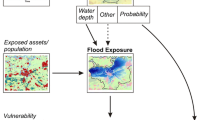
Overview
- The book combines selected research results, framed by contemporary descriptions of meteorological base of flood forecasts, regionalization, etc.
- The contributors are the leading scientists in the field
- It is a comprehensive, interdisciplinary and practically orientated book of topical scientific interest
Access this book
Tax calculation will be finalised at checkout
Other ways to access
About this book
Flood catastrophes which happened world-wide have shown that it is not sufficient to characterize the hazard caused by the natural phenomenon "flood" with the well-known 3M-approach (measuring, mapping and modelling). Due to the recent shift in paradigms from a safety oriented approach to risk based planning it became necessary to consider the harmful impacts of hazards. The planning tasks changed from attempts to minimise hazards towards interventions to reduce exposure or susceptibility and nowadays to enhance the capacities to increase resilience. Scientific interest shifts more and more towards interdisciplinary approaches, which are needed to avoid disaster. This book deals with many aspects of flood risk management in a comprehensive way. As risks depend on hazard and vulnerabilities, not only geophysical tools for flood forecasting and planning are presented, but also socio-economic problems of flood management are discussed. Starting with precipitation and meteorological tools to its forecasting, hydrological models are described in their applications for operational flood forecasts, considering model uncertainties and their interactions with hydraulic and groundwater models. With regard to flood risk planning, regionalization aspects and the options to utilize historic floods are discussed. New hydrological tools for flood risk assessments for dams and reservoirs are presented. Problems and options to quantify socio-economic risks and how to consider them in multi-criteria assessments of flood risk planning are discussed. This book contributes to the contemporary efforts to reduce flood risk at the European scale. Using many real-world examples, it is useful for scientists and practitioners at different levels and with different interests.
Similar content being viewed by others
Keywords
Table of contents (12 chapters)
-
Front Matter
-
Back Matter
Editors and Affiliations
About the editor
Prof. Andreas Schumann studied hydrology and water management at the Technical University, Dresden. From 1981 to 1988 he held different positions in water management authorities: district hydrologist, head of a department and vice-director. From 1989 to 2001 he was a senior lecturer for Hydrology and Water Management at the Ruhr- University Bochum. Since 2001 he has the chair for Hydrology, Water Management and Environmental Techniques at the Ruhr- University Bochum, Germany. Prof. Schumann is Vice-President of ICWRS (Water Resource Systems) of International Association of Hydrological Sciences.
Bibliographic Information
Book Title: Flood Risk Assessment and Management
Book Subtitle: How to Specify Hydrological Loads, Their Consequences and Uncertainties
Editors: Andreas H. Schumann
DOI: https://doi.org/10.1007/978-90-481-9917-4
Publisher: Springer Dordrecht
eBook Packages: Earth and Environmental Science, Earth and Environmental Science (R0)
Copyright Information: Springer Science+Business Media B.V. 2011
Hardcover ISBN: 978-90-481-9916-7Published: 05 January 2011
Softcover ISBN: 978-94-007-8983-8Published: 15 October 2014
eBook ISBN: 978-90-481-9917-4Published: 04 January 2011
Edition Number: 1
Number of Pages: X, 279
Topics: Hydrogeology, Environmental Management, Physical Geography



